Did you know that there are 58 UNESCO Heritage Sites in Italy, the most in any country in the world? It is not hard to work out why. Italy’s rich history dates back to before the Roman empire and with a profusion of historical, cultural and natural sites, stunning landscapes and even active volcanoes, it is no surprise that there are so many UNESCO Sites in Italy.
Stretching from the northern Italian alps, the Dolomites mountain range through the diverse landscape of central Italy, to the heel of the “boot” in the south, there is a proliferation of UNESCO sites in Italy.
*This site uses affiliate links and I may earn a small commission when you use my links and make a purchase without incurring an additional fee yourself.
Thank you for supporting this website. See my disclaimer page for more details.
If you are putting together a UNESCO list of Italian sites to see, be sure to include some of the following.
First published: 16 January 2023
Let’s explore some of the UNESCO Sites in Italy
Church and Dominican Convent of Santa Maria delle Grazie with “The Last Supper” by Leonardo da Vinci – 1980
Contributed by Larch from The Silver Nomad
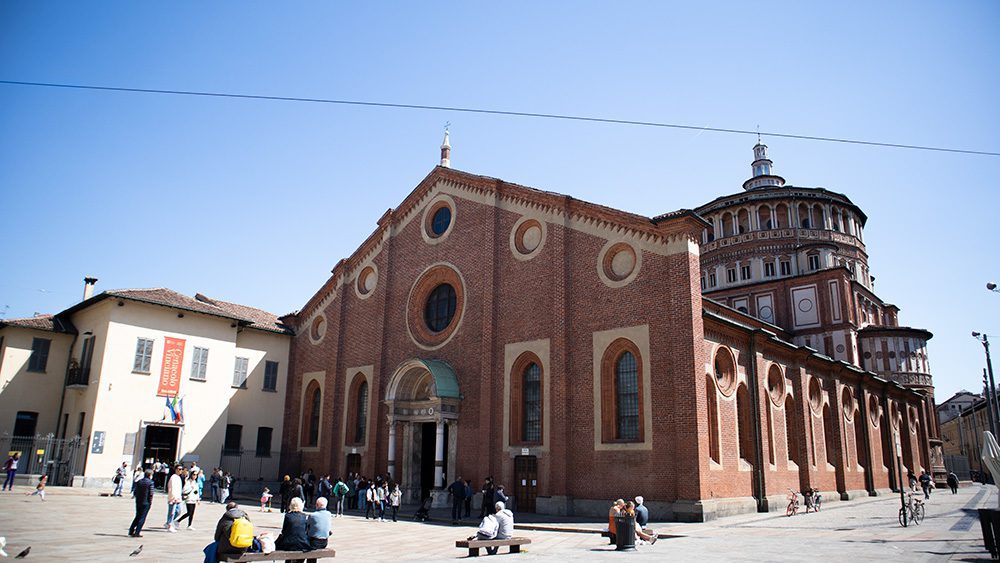
The second site in Italy to gain UNESCO World Heritage status is the Church and Dominican Convent of Santa Maria delle Grazie in Milan. The building of the refectory was started in 1463 and the unassuming red sandstone building holds one of Italy’s most famous paintings.
“The Last Supper” or L’Ultima Cena is the painted mural that dominates the entire wall of one of the dining halls of the monastery. The mural depicts the reactions of the disciples when Jesus tells them that one will betray him.
Painted between 1495 and 1498 by one of Italy’s great artists of the renaissance period, Leonardo da Vinci. Unusually, da Vinci used pigments directly onto the dry walls instead of the normal practice of mixing pigments with wet plaster. This has led to some flaking and the colours fading. The fresco has been repaired over the years.
During the Second World War, the complex was hit by Allied bombing. While the buildings suffered some damage, the Last Supper survived intact.
Although The Last Supper is a big draw for tourists, take time to appreciate the rest of the 15th Century complex. The Church and the Convent include a large drum-shaped dome, large apses and gardens.
It is a very popular and if you turn up on the day, you may not be able to get in. It is recommended to buy your tour tickets for “The Last Supper” as far in advance as you can as they sell out very quickly.
Address: Piazza di Santa Maria delle Grazie, 20123 Milano
Historic Centre of Rome, the Properties of the Holy See in that City Enjoying Extraterritorial Rights and San Paolo Fuori le Mura – 1980
Contributed by Isabelle from Issy’s Escapades
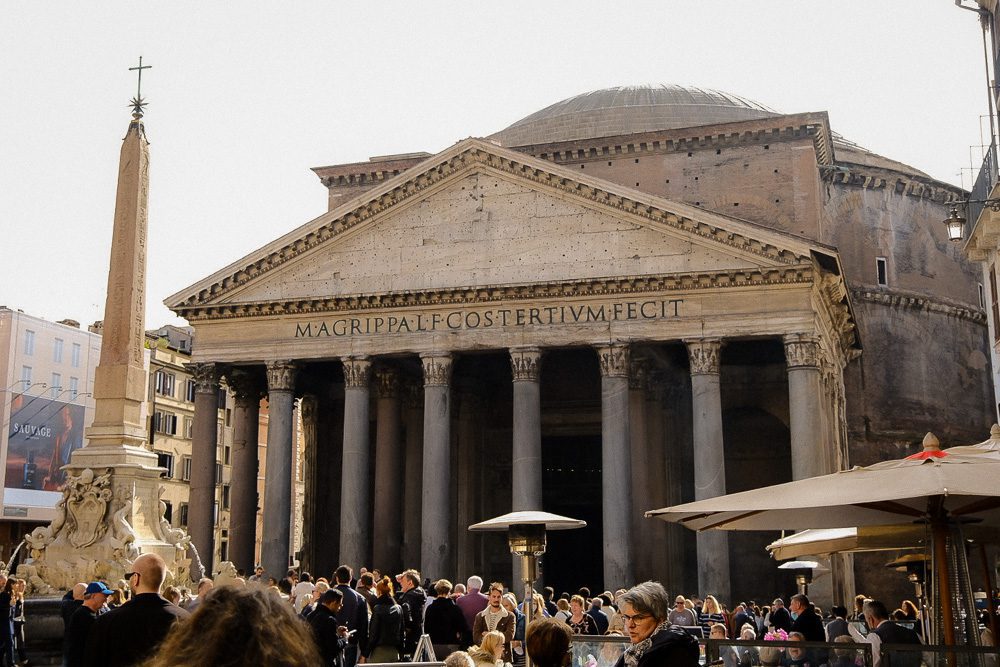
To walk the streets of the Centro Storico of Rome is to make your way through an open-air museum, and thus it is fitting that the entire historic centre of Rome is designated as a UNESCO World Heritage Site.
While you would expect great Roman monuments such as the Pantheon, the Colosseum and the Roman Forum, as well as the later additions such as the Trident in Piazza Navona, to be UNESCO sites in their own right, the fact that the centre of Rome is so densely packed with points of antiquity means that the entire centre itself has found its way onto the list.
The centre of Rome showcases a history that has spanned over three millennia, boasting Ancient Roman engineering and architecture, urban planning that was ahead of its time, great basilicas and Renaissance and Baroque art and design – in fact, Baroque art was born in the city of Rome.
According to legend, the city of Rome was founded in 753 BC by brothers Romulus and Remus. Their city was first the centre of a republic, then an empire, and finally the capital of the Catholic Church. It’s quite a history!
The best way to see the historic centre of Rome is to allocate a number of days to see it if you have not visited it before. While you will to a certain extent be able to walk its streets and take in some of its main monuments for free, a considerable number of attractions will require tickets and booking in advance.
Opening times and prices vary for each, as do the lead-up times to the availability of tickets. It is highly recommended to book tickets to venues like the Colosseum and the Borghese Gallery well in advance.
Historic Centre of Florence – 1982
Contributed by Larch from The Silver Nomad

Spanning the Arno River, the city of Florence in Tuscany is a must for lovers of art, history, and culture, in fact, anyone who adores Italy. The Historic Centre of Florence has been one of the most popular UNESCO Heritage sites in Italy since its inclusion in 1982.
Wander the streets and you are spoilt for choice with museums, art galleries, bell towers and duomos to climb, squares full of cafes and restaurants and the beautiful Boboli botanical garden to hang out in.
The skyline is full of terracotta-roofed buildings topping pastel yellow and cream buildings but is dominated by the magnificent Santa Maria del Fiore Duomo. The Santa Maria del Fiore Duomo stands 114m tall (376 ft) and has amazing views from the top if you fancy a climb. Get your entrance tickets to the Duomo Complex and Cupola climb in advance here.
If you are looking for art galleries, the Uffizi Gallery with the famous Botticelli “Birth of Venus” amongst other amazing paintings, and sculptures, or head to one of the former Medici villas Pitti Palace. The Medici family ruled Florence in the 13th Century and left their mark on the city with palaces and gardens.
Wander across the Ponte Vecchio, the oldest and most famous of Florence’s bridges. The medieval stone arch bridge over the Arno River is lined with shops which used to be a common feature of bridges.
If you are visiting Florence in June, look out for the Calcio Storico Fiorentino. A mix of football, rugby, and wrestling started in 16th century Florence. It is still played today in traditional historical costumes!
Piazza del Duomo, Pisa – 1987
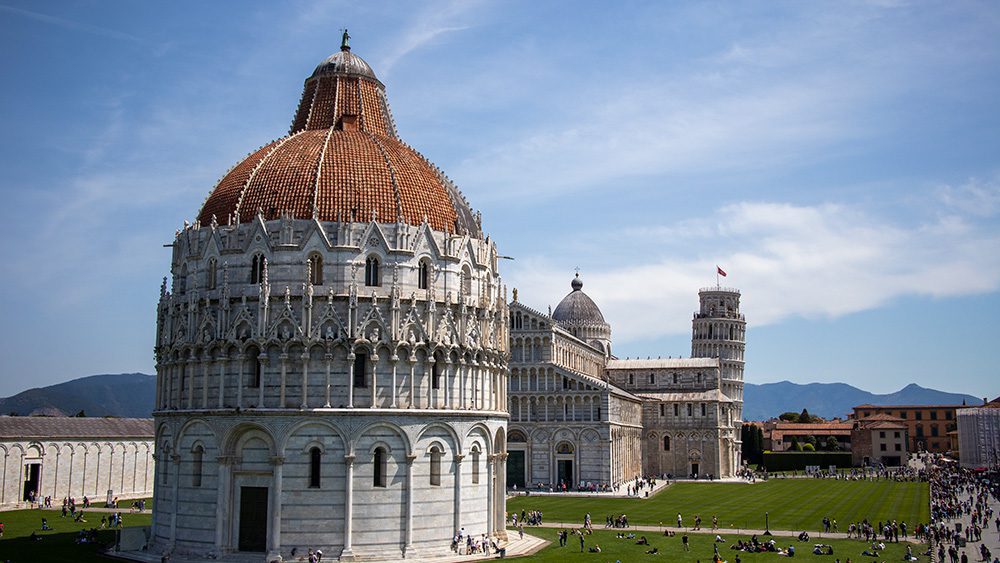
Contributed by Larch from The Silver Nomad
Near the top of many people’s bucket lists for Italy is Pisa. Renowned for the Leaning Tower of Pisa, the Unesco World Heritage site of Piazza del Duomo actually includes four masterpieces of medieval architecture.
Situated in the Piazza dei Miracoli, the Piazza del Duomo includes the cathedral, the baptistry, the campanile (the bell tower or ‘Leaning Tower’) and the cemetery.
A climb up the Leaning Tower is a must, and as it is so popular, it is best to buy your tickets in advance. Another favourite activity is joining the multitudes and taking photos of their friends “holding up” the tower. It can be tricky to do, to get the right angle, but the effects can be fun though!
For great views and photos, take a walk around the city wall. The elevated walk gives you excellent views of all the buildings from different angles. There is a small charge, but it is well worth it.
Venice and its Lagoon – 1987

Contributed by Pamela from The Directionally Challenged Traveler
Venice and its Lagoon have been a UNESCO World Heritage Site since 1987. Its unique archaeological, historical, and artistic heritage are delicately integrated into the natural landscape.
Spread over 118 small islands, the islands of Venice delicately balance breathtaking architecture and vibrant history. The city is home to various works of art by famous artists including Veronese and Tintoretto. Walking through the alleys of Venice, it’s impossible not to be in awe at St. Mark’s Basilica and Doge’s Palace (Palazzo Ducale in Italian).
Travellers will find plenty of things to do in Venice beyond just the beautiful architecture and art. Taking a gondola ride is an essential Venetian experience. Seeing the city from the water gives you a new perspective. Sail beneath the shining white Rialto Bridge and past the Bridge of Sighs.
The lagoon that the gondolas are on has seen a lot of history, dating back to the 5th century. The Venetian population originally found temporary settlements from barbarian raids. Since then, the lagoon has become an incredibly unique and vulnerable habitat.
The food of Venice is a source of pride for the Venetian people. Enjoy an aperitif in the early afternoon and gelato at night – remember calories don’t count on vacation! The seafood is fresh and the wine is locally sourced.
No matter what you decide to do, you’ll be glad you visited the floating city of Venice!
The Sassi of Matera and the Park of Rupestrian Churches – 1993
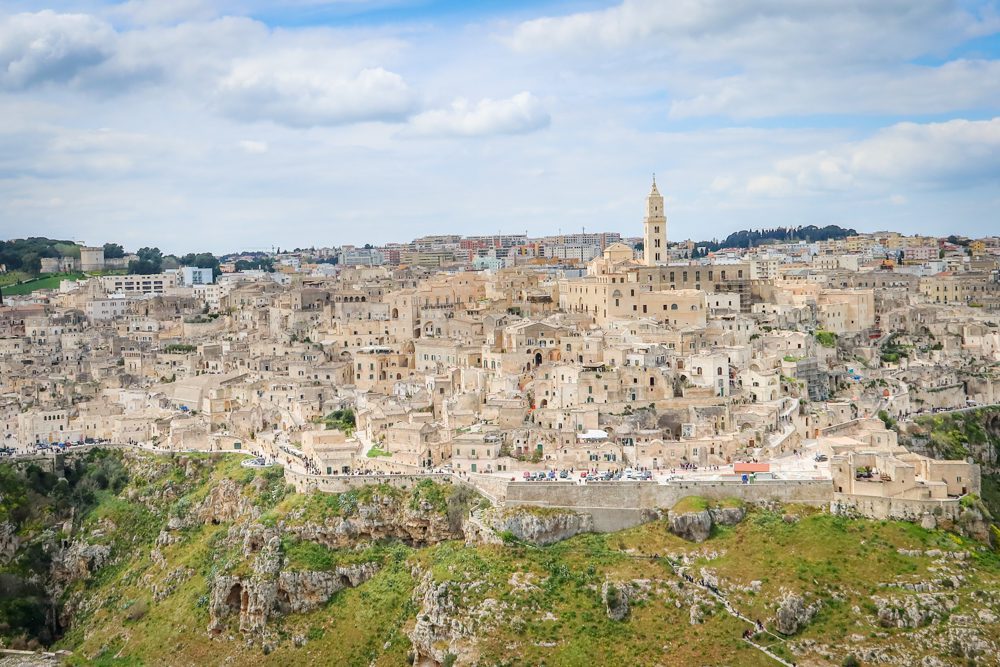
Contributed by Katy from A Rambling Unicorn
Matera is a stunningly beautiful city perched along two picturesque canyons in Italy’s Basilicata region. The city is renowned for the Sassi of Matera, a network of cave dwellings that are carved into the limestone canyon walls.
This ancient settlement is so well-preserved that it is commonly used as a filming location. Famous examples include The Passion of the Christ and Wonder Woman – along with the latest James Bond Movie No Time to Die.
Historians believe Matera was first settled 10,000 years ago – making it one of the oldest continuously inhabited settlements in the world. The nearby grottoes were colonized by Benedictine and Basilian monks in the Early Middle Ages who transformed them into distinctive rock churches.
In the early 20th century, living conditions in the Sassi neighbourhoods of Matera declined significantly. Branded as “The Shame of Italy,” the entire population was evacuated in 1952. Now, however, the city has rebounded and transformed into an incredible tourist destination.
Matera was named a European Capital of Culture in 2019 and declared a UNESCO World Heritage Site in 1993. The UNESCO site includes both the Sassi of Matera and the Park of Rupestrian Churches located across the Gravina River Canyon. The park features over 150 Rupestrian rock churches and incredible views of Matera from the Belvedere Murgia Timone overlook.
The Sassi of Matera and the Park of Rupestrian Churches are both free to enter and open 24 hours a day. That being said, some of the most important cave churches are only open during the daytime hours.
Historic Centre of Naples – 1995
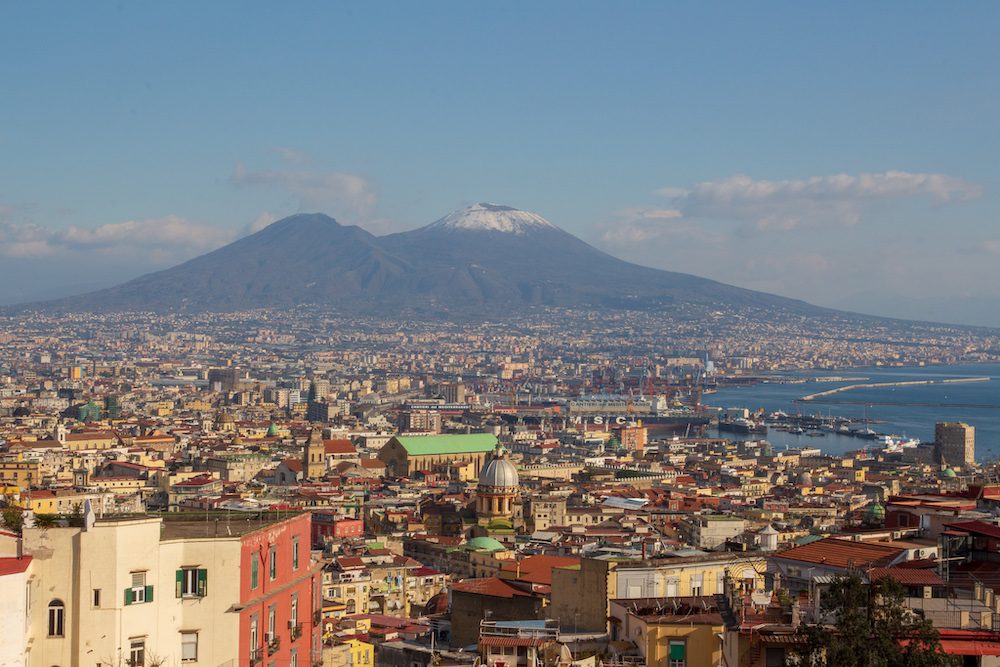
Contributed by Alex from Just Go Exploring
Naples is Italy’s third largest city and one of the oldest in Europe, with over 3,000 years of history. Located in the southern region of Campania, the city enjoys an incredible natural setting on the sweeping Bay of Naples.
Initially founded in the 9th century BC, Naples has been an important port from the time of the ancient Greeks to the present day. Several empires and civilizations controlled Naples throughout this period, including the Romans, Byzantines, the Normans, Sicilians, and the Aragonese of Spain.
A large portion of the modern city is included within the UNESCO site. This is a testament to Naples’ long and rich history and its wealth of archaeological and culturally significant sites. As a result, much of this “site” is totally free to visit and can be explored day and night, 365 days a year.
Due to its size and location, the UNESCO site contains a large number of important architectural features, churches, palaces, other buildings and locations. Even the linear grid layout of the Centro Storico itself formed a core part of the ancient Greek city of Neapolis.
There are so many amazing things to see and do in the historical centre of Naples. It would take several days to explore all of this huge site properly, but some of the most interesting bits to visit are as follows:
- Castel Nuovo
Castel dell’Ovo - Quartieri Spagnoli (Spanish Quarter)
- Santa Chiara monastery
- Naples Cathedral
- the churches of San Domenico Maggiore and Gesù Nuovo
- sections of the ancient Greek town walls
- Piazza Dante
- Piazza del Plebiscito (including the Royal Palace)
Early Christian Monuments of Ravenna – 1996

Contributed by Larch from The Silver Nomad
Ravenna, is home to not one, but eight different UNESCO historical site. An easy train journey to the south of Bologna in the Emilia-Romagna region, Ravenna is an ideal city to spend a day or two to spend a day or two.
All eight of the UNESCO buildings – the Mausoleum of Galla Placidia, the Neonian Baptistery, the Basilica of Sant’ Apollinare Nuovo, the Arian Baptistery, the Archiepiscopal Chapel, the Mausoleum of Theodoric, the Church of San Vitale and the Basilica of Sant’Apollinare in Classe – were constructed in the 5th and 6th centuries.
At the time Ravenna was the centre of the Roman Empire then it was the seat of the Byzantine Empire until the 8th century.
As you visit each of Ravenna’s UNESCO sites, marvel at the intricate mosaics, the exquisite ceilings and the beautiful architecture. It is advisable to book a tour, though if you decide to visit the sites on your own, buy a ticket which gives you entrance to five of the monuments.
It is easy to walk between the various sites, and there are plenty of piazzas and coffee shops to sit in and enjoy the views.
Although it is not a UNESCO site, don’t miss the Tomb of Dante in Via Dante Alighieri. The neo-classical building has a sarcophagus which contains his bones. Dante was the famous Italian writer of “The Divine Comedy” and “The Inferno” and although born in Florence, he was exiled and made his home in Ravenna.
The Trulli of Alberobello – 1996

Contributed by Nadine from Le Long Weekend
Puglia’s unique Trullo houses are sprinkled throughout the region, but the Trullo town of Alberobello takes things to a whole new magical level! With over 1500 Trulli located in and around the southern Italian town, they’ve helped earn Alberobello its UNESCO World Heritage Site status.
The Trullo town of Alberobello, also known as Rione Monti, sits to the south of the main city and is where you’ll find the highest concentration of Trullo houses, and even a Trullo Church! These conical buildings were originally constructed without the use of mortar, meaning they weren’t seen as permanent structures. This allowed the thrifty inhabitants to avoid paying property taxes.
These days, the Trullo are well and trulli here to stay, and the majority house boutiques, restaurants, and even accommodation for a super unique place to stay in Puglia! Alberobello is located around an hour’s drive from the two main airports in Puglia – Bari and Brindisi. And once you reach the town of Alberobello, the Trullo town is clearly indicated.
There is no charge to visit the village, but you will have to pay for parking which gets more expensive the closer you park. Again, it doesn’t have opening hours as such, but it may pay to check the opening hours of the various boutiques and restaurants you’ll want to visit in advance. Generally, in the summer months, the opening hours extend into the evening.
Archaeological Areas of Pompei, Herculaneum and Torre Annunziata – 1997

Contributed by Mayuri from ToSomePlaceNew
Pompeii is one of the most popular tourist destinations in Italy. Every year, millions of people visit the city to see its well-preserved ruins and learn about its history. This UNESCO World Heritage Site was founded around 600 BCE, and by the time it was destroyed by the eruption of Mount Vesuvius in 79 CE, it was home to around 20,000 people.
The city was rediscovered in the 18th century, and since then, archaeologists have excavated much of it. Today, visitors can explore the ruins of Pompeii and see many of the same things that the city’s residents would have seen before the eruption.
Pompeii is located in the southern part of Italy, about 20 kilometres (12 miles) southeast of Naples. A tour of the site is also possible from Rome.
The city was built on a flat piece of land between two mountains, Mount Vesuvius and Mount Somma. Pompeii was divided into three parts: the urban center, the suburban area, and the rural area.
The best time of the year to visit Pompeii is during the off-season, between November to March since the summer season is busy with tourists. It is also much cooler to wander around the site in the winter months.
It is best to book a tour with a local guide to understand its history, and also make use of your time in Italy. The complex is huge, and having a guide will be helpful. The entrance fee is 11 euros to enter the Pompeii Ruins. Plan to spend 3-4 hours (with or without a guide). You can also rent an audio guide.
Portovenere, Cinque Terre and the Islands (Palmaria, Tino and Tinetto) – 1997
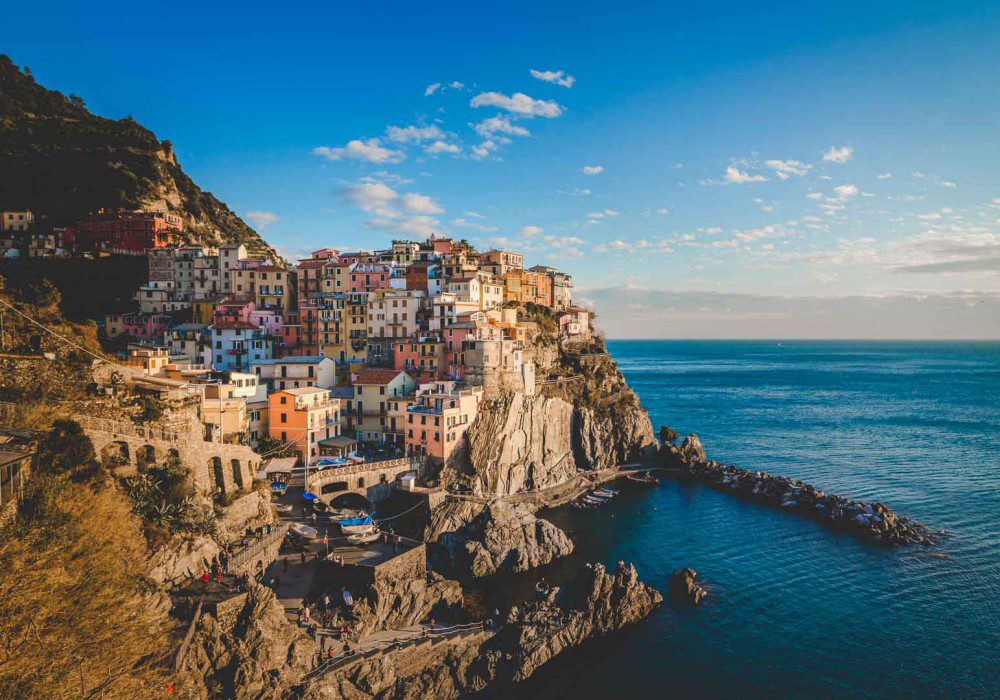
Contributed by Nesrine from Kevmrc
Located in Liguria on the northwestern coast of Italy, the Cinque Terre National Park is worldwide famous for its authentic landscapes, its traditional culture, and the kindness of its people. Classified as a UNESCO World Heritage Site since 1997, the region includes the five villages of Monterosso El Mare, Vernazza, Corniglia, Manarola and Riomaggiore; the small town of Porto Venere, and the islands of Palmaria, Tino and Tinetto.
Also known as the smallest Italian national park in size, Cinque Terre is nevertheless one of the most impressive. With its dramatic cliffs, seaside hiking trails, exceptional wildlife and breathtaking views, this national park is a true piece of paradise. But the colourful houses hanging on the cliffs of the five small villages are certainly the most popular attraction of the region, and more widely in Italy.
Atypical and photogenic, these villages are perfectly integrated into the natural landscape. Visiting Cinque Terre is a must to experience the Dolce Vita, and you certainly will not get bored there. Boat rides (with stunning views of the cliffs), paddle boarding, snorkelling, and cultural visits… the region offers plenty of activities. You can even find some beaches in Cinque Terre, which is perfect if you’re going in summer.
But one of the best ways to visit is definitely hiking: close to each other, you can take the beautiful paths to walk from one village to another. But if you don’t have much time, you can also take the train between each village. And to reach the beautiful islands of Palmaria, Tino and Tinetto, you can simply take the boat from Porto Venere that serves the islands several times a day.
Residences of the Royal House of Savoy – 1997

Contributed By Or from My Path in the World
Scattered around Piedmont, you’ll find more than ten palaces, castles, and villas listed as one UNESCO World Heritage Site called the Residences of the Royal House of Savoy.
The Savoy dynasty ruled the northern Italian region for several centuries, reigning the Duchy of Savoy, the Kingdom of Sardinia, and the unified Kingdom of Italy. Most of its royal residences in Piedmont date back to the 15th-18th centuries, though some were originally built in the 9th-12th centuries. They are also dominated by the Baroque style and designed by several main architects – Amedeo and Carlo di Castellamonte, Filippo Juvarra, and Guarino Guarini.
In the capital of the region, Turin, which was also the capital of the Savoy’s kingdoms, you’ll find the beautiful Palazzo Reale (considered the most important), Palazzo Madama, Palazzo Carignano, Castello del Valentino, and Villa della Regina. The visit to the Palazzo Reale is also combined with a few other landmarks, including the Royal Armory and the Sabauda Gallery.
Easily reachable from Turin, you can also visit the Palace of Venaria (be sure to get your ticket in advance), Stupinigi Royal Hunting Lodge, and the Moncalieri Castle.
All of the Residences of the Royal House of Savoy are free to visit with the Torino+Piemonte Card.
Su Nuraxi Barumini – 1997
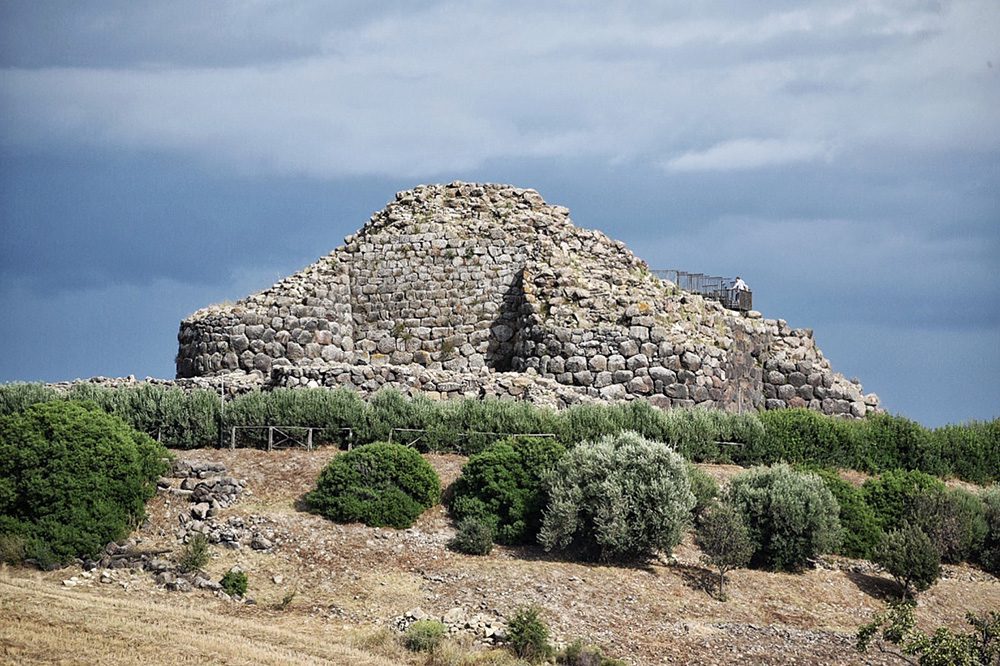
Contributed by Claudia from Strictly Sardinia
Nuraghe are ancient megalithic constructions only found in Sardinia. They were typically built between 1900 and 730 BC. Debate is still ongoing as to what their functions were. Some suggest they had defensive purposes, others that they were used as homes of the rulers. It’s probably a mix of the two.
Scattered around Sardinia there are around 7000 nuraghe, most of them still requiring to be fully excavated. While only one of them, Su Nuraxi of Barumini, is a UNESCO World Heritage site, there is an ongoing campaign to include the whole “nuragic landscape” in this UNESCO recognition.
There are various types of nuraghe in Sardinia, and they can be roughly placed into five different categories: protonuraghe, which is the oldest one and where the buildings have an irregular shape and layout; mixed nuragle; single tower nuraghe, characterized by one single conical tower; the “tancadu,” which sees the addition of a circular building to the main tower; and polylobed nuraghe, the royal palace of the nuraghe where various buildings are connected to the towers.
Su Nuraxi dates back to around 1600 BC and was inhabited until the 3rd century AD. It’s a polylobed nuraghe with four towers connected by a wall, and entirely built in basalt, a volcanic stone easily available on the island.
The site is located close to the town of Barumini, about 45 minutes’ drive from Cagliari, the capital of Sardinia. It’s open every day from 9:00 am to, either, 5:00 or 8:00 pm, depending on the season. Tickets are €14 for adults. All visitors are grouped by language and taken around by a guide which is included in the price.
Villa Romana del Casale – 1997

Contributed by Annabel from Smudged Postcard
Villa Romana del Casale is home to some of the most well-preserved Roman mosaics in Europe. This UNESCO site is located close to the town of Piazza Armerina in central Sicily, around 165 kilometres from the capital Palermo and 100 kilometres from Catania. The site is best reached by car.
Villa Romana del Casale is thought to have been the home of a wealthy Roman family with excavated rooms suggesting the setting was both residential and administrative. Dating back to the 4th century, the skilfully produced mosaics depict a wide range of scenes – everyday Roman life, mythical stories, as well as hunting and fighting scenes. The mosaics cover an area of some 3,000 square metres and are thought to have been produced by North African artisans.
The villa was covered by a landslide in the 12th century and lay hidden until it was rediscovered in the 19th century. It has been listed as a UNESCO World Heritage site since 1997.
Entry to Villa Romana del Casale is €10 per person, €5 for young people. The first Sunday of the month has free entry. The site is open daily – in the summer from 9 am to 7 pm, in winter from 9 am to 5pm.
Villa Adriana in Tivoli – 1997
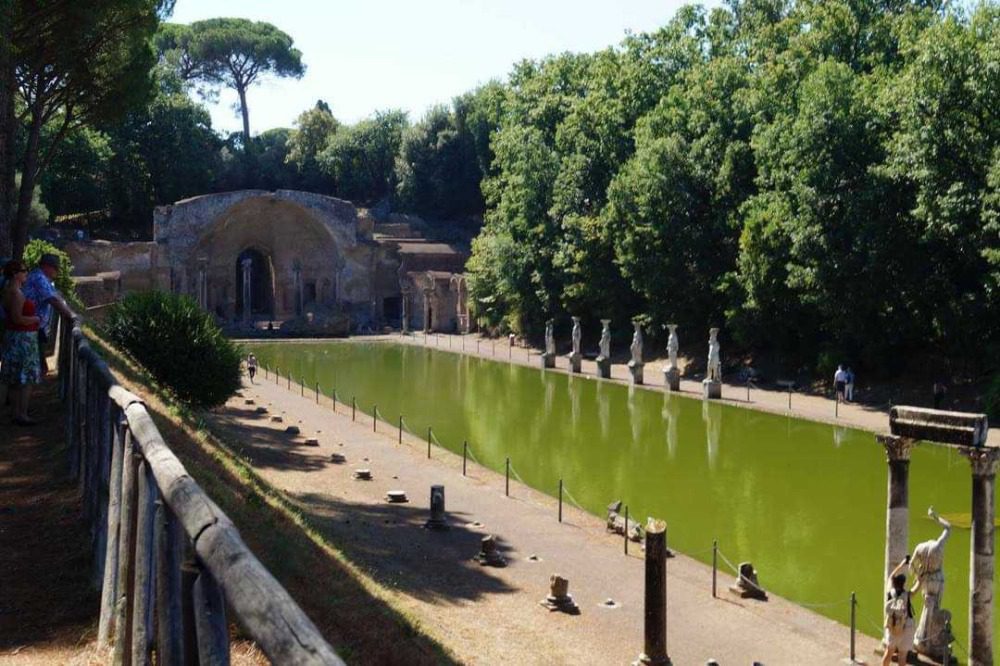
Contributed by Mary from Wanderu
Villa Adriana, or Hadrian’s Villa, is a complex of archaeological ruins and a UNESCO World Heritage Site in Tivoli. The ruins are the remains of Roman Emperor Hadrian’s enormous villa complex, created around the year 120 A.D. Although the emperor had an opulent palace in Rome, he wanted a place to escape the city and ordered the construction of this villa and the libraries, theatres, pools, and stadiums that went with it.
The site is one of the richest and best-preserved complexes from the era, which makes it an incredible experience for visitors to explore architecture, urban planning, culture, and art from Classical Antiquity.
Villa Adriana is located just outside of Tivoli (very close to another ancient complex, Villa d’Este) It is super easy to take a train from Rome into Tivoli for a day trip exploring this extraordinary complex. Visiting the site requires a ticket, for just € 8, and you can visit any day between 9 AM and 5 PM. The complex remains open even later during the summer months.
Give yourself a few hours to wander through the whole complex. Some highlights include the Canopus, a canal lined with statues, and the thermal bathhouses. There are many more sights to see, including a stadium, gardens, temples, and the Antinoeion: a temple that many suggest Hadrian dedicated to his lover Antinous who died young. Each area of the villa complex is similarly rich with stories, emotion, and wonder, well worth exploring while in Italy.
City of Verona – 2000

Contributed by Dhara from It’s Not About the Miles
Verona’s historic centre is one of Italy’s many UNESCO World Heritage Sites. Romantic Verona, the setting for Shakespeare’s Romeo and Juliet, is definitely one of the most beautiful places to visit in Northern Italy!
Among the best things to do in Verona is simply to stroll the historic centre to take in the beautiful architecture, pretty balconies, and lively squares.
Take the lift (or climb the steps!) to the top of the Lamberti Tower for spectacular views over the rooftops of Verona. Another must-visit place for views is the compound of the Castel San Pietro, on the opposite side of the Adige River. Seeing the city spread out below you is extraordinary.
When in Verona, you have to get your photo taken while you pose on Juliet’s balcony! But even if you do not get snapped, it’s worth visiting the much-hyped balcony, and the little museum that houses costumes and the bed from the 1968 movie by Franco Zeffirelli.
Verona is home to many Roman-era structures, none more impressive than the Verona Arena. The magnificent amphitheatre is still in good condition, and actually hosts performances in the summer.
And lastly, Verona’s many beautiful churches should definitely be on your itinerary for the city. Verona’s cathedral complex is beautiful, as is the Basilica di Santa Anastasia.
For lovers of art, architecture, and history, Verona’s centro storico is a must-visit on a trip to Italy.
Villa d’Este in Tivoli – 2001
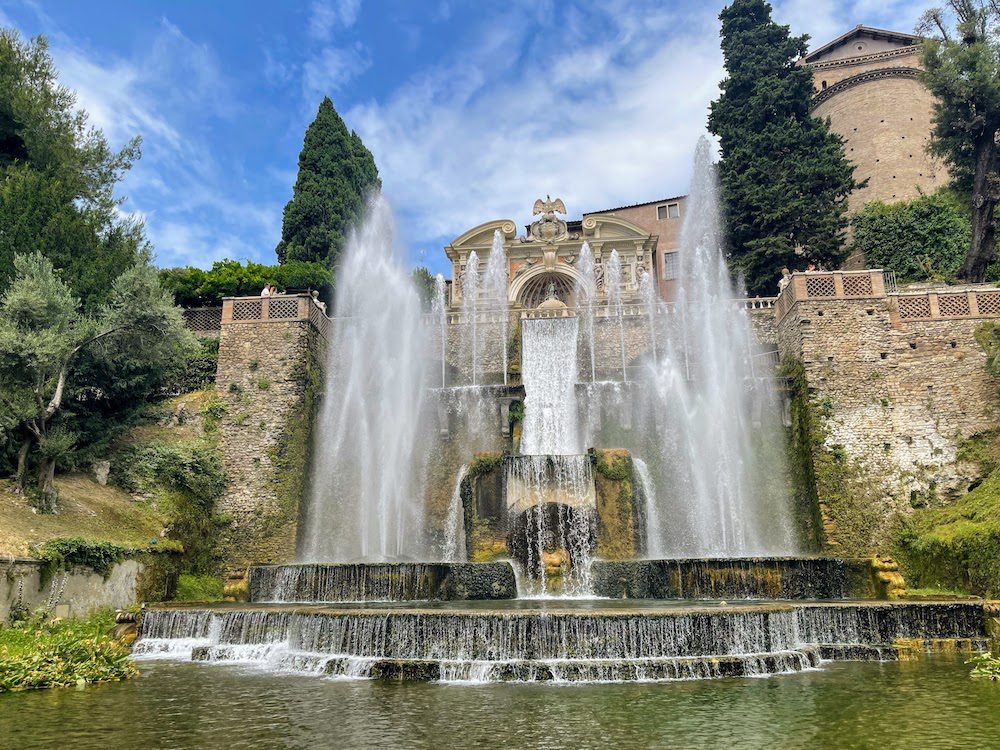
Contributed by Susanna of Curiosity Saves
The stunning gardens and water fountains of Villa d’Este, Tivoli, embody some of the best of the Renaissance culture, architecture, and design.
Located just outside Rome, this UNESCO site is a highly recommended day trip from the Eternal City. Villa d’Este is a compound featuring over 50 water fountains, grottos, and water features that cascade through lush green gardens. After a new governor of Tivoli was named, they wanted a palace to honor their new position and commissioned architect Pirro Ligorio.
The grounds are unique because the architect worked with and around the historic monastic building previously in the location, contributing to a distinctive design. It was this irregular design that helped propel it to UNESCO status, and it is now renowned as one of Italy’s must-see sites and a truly remarkable Renaissance site.
One emerges out into the terraced gardens after entering through a museum with walls painted in original Renaissance art. The top-level terrace offers sweeping views of surrounding villages and rolling hills. It is recommended to get lost and meander through the gardens to see all the different fountains. Each one is vastly different than the last, but the oval fountain, right at the center of the gardens, is both the oldest and most famous.
Tickets are about 12 euros, and the gardens are open in the summer from 8:45 am – 9:45 pm. Closed: Monday mornings. Admission is free on the first Sunday of the month.
Late Baroque Towns of the Val di Noto (South-Eastern Sicily) – 2002

Contributed by Soumya from Stories by Soumya
A lesser-known but stunningly beautiful UNESCO World Heritage Site in Italy is a cluster of 8 charming towns in Sicily, known as the Late Baroque Towns of Val di Noto.
Val di Noto includes the towns of Ragusa, Modica, Scicli, Noto, Palazzolo, Catania, Caltagirone, and Militello Val di Catania, all of which were reconstructed after the devastating earthquake of 1693. Over a period of time, they all came to represent a typical architectural style which was a mix of mainland Baroque and a local Sicilian flair. The style was called Sicilian Baroque.
Taking a walking tour through these Baroque towns is one of the best things to do in Sicily. You’ll explore richly-sculpted Baroque facades, flamboyant balconies, coloured marbles and mosaics, and an abundant display of grinning masks and peaceful angels.
It is an absolute delight to walk through the undulating hills of Ragusa, one of the most charming towns in the Val di Noto ensemble. The city boasts of lavish Baroque churches and offices as well as a stunning view of the old town by the valley.
Do not miss a trip to Modica which is famous for its dark chocolate produced by indigenous techniques for centuries now.
Late spring and early fall are good times to visit. Milder temperatures and plenty of sunshine make Sicily’s Baroque alleys look even prettier.
The Etruscan Necropolis of Cerveteri – 2004
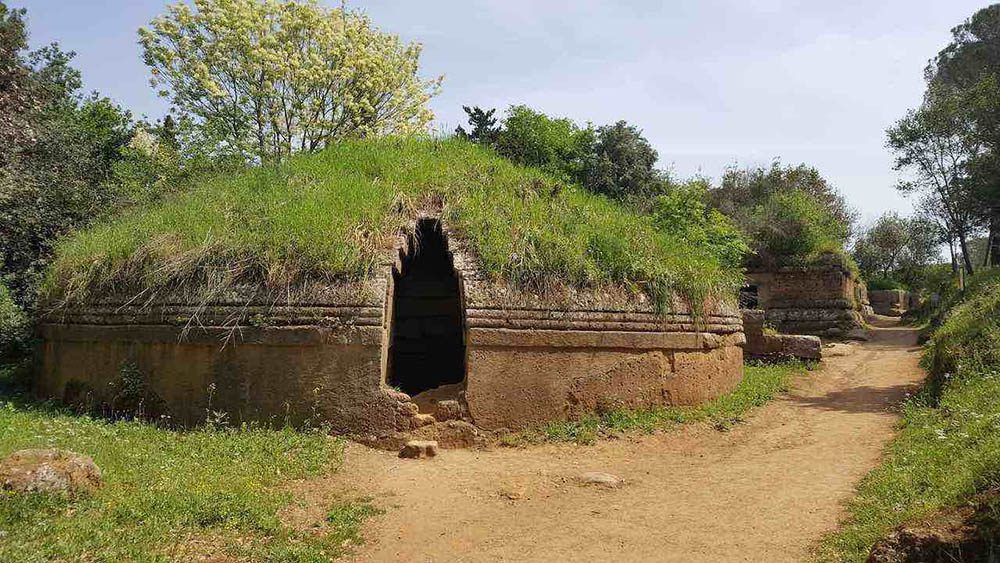
Contributed by Lisa of Travel Connect Experience
The Etruscans, the great civilization which preceded the Romans in dominating the territory stretching from Naples to Bologna, flourished between the 10th and 3rd centuries B.C. Being profound devotees of the afterlife, they built numerous necropolises, dozens of which you can discover while hiking across Latium, Umbria, and Tuscany.
The Etruscan Necropolis of Cerveteri has been listed by UNESCO since 2004. Unlike the other Etruscan necropolises, this one has the appearance of a monumental city of the dead, with a Way of the Underworld which crosses it from east to west and is almost 2 kilometres long. According to archaeologists, the necropolis has been divided into 3 parts: the Area of the Fence, the area of the Great Tumuli, and the Area of the Pond with the Way of the Underworld.
All of them can be reached by following the road Via della Necropoli for 1.5 km from the historic centre of the town of Cerveteri.
The Area of the Fence is the only one for which a ticket is required (€6, open Wed. through Sun, 9 AM to 7:30 PM). It gathers about 2000 tombs, including those belonging to the wealthiest families, real houses provided with several rooms, beds, and pillars, which are all carved into the tufa rock. Another very suggestive part of the necropolis is the Way of the Underworld, a corridor dug into a wall of tufa rock that has hundreds of tombs on different levels. In order to visit the Etruscan tombs in the most efficient way, bring a flashlight with you and wear hiking shoes.
Genoa: Le Strade Nuove and the system of the Palazzi dei Rolli – 2006

Contributed by Sarah from A Social Nomad
The richest Noble families of Genoa built their stately homes along the Strada Nuova in the years between the Renaissance and the Baroque era, the time known as the Golden Century. These sumptuous palaces had a unique purpose in Genoa, they were included in the “Rolli” – a list, albeit unofficial, of lodging palaces available for state visits.
In 2006, 42 of these palaces were added to the UNESCO World Heritage list. The full listing actually includes the streets and the entire system of the Rolli Palaces and strolling past them, or visiting is one of the top things to do in Genoa. While some of these palaces are still privately owned and some are offices or banks, that doesn’t stop them from being magnificent.
Simply step into any of the banks or offices and look up, the artwork is sublime. Each year Genoa celebrates the “Rolli Palaces” with Rolli Day events, the date changes each year, so you’ll need to watch out for it.
One of the most famous (and open to the public) is the Palazzo Reale, which you’ll find at 10 Via Balbi. It is open Wednesday through Saturday from 1 pm until 7 pm. The Royal Palace includes many magnificent seventeenth-century masterpieces, including paintings by Veronese and Van Dyck. Entrance is covered on the 15 Euro Genoa Museum Pass, but a tour of the Rolli Palaces and guided entry will enhance your visit immensely.
Mount Etna – 2013

Contributed by Veronika from Travel Geekery
Did you know that Mount Etna is the most active stratovolcano in the world? As if that weren’t significant enough, it’s also one of the highest volcanoes in Europe. No wonder this natural site has been inscribed on the UNESCO World Heritage List in 2013.
You can find Etna in the Northeast of Sicily between the cities of Messina and Catania. The volcano has erupted countless times during its 500,000 years of existence. Since the beginning of the 20th century, Etna has been active more than ever before. The last recorded major eruption happened in February 2021, which increased Mount Etna’s height by 30 meters.
To visit Mount Etna, you simply drive to one of its parking lots – e.g. the biggest one right by the Rifugio Sapienza Hotel. There are several craters right around the parking lot, which you can visit freely.
There’s a cable car that can take you for €30 near the summit of Mount Etna at the height of 2,500 meters. From there, you can hike further up until about 2,800 meters. It’s also possible to buy a combo of a cable car ride and a ride in a 4×4 for €50 to get even higher and walk just the last part (still an hourlong hike) to get to 2,900 meters. The cable car is in operation daily from 9 am to 4 pm in the summer season (April to November), weather permitting.
Mount Etna can be easily visited on a day trip from Catania as it’s only about an hour by car.
Arab-Norman Palermo and the Cathedral Churches of Cefalù and Monreale – 2015
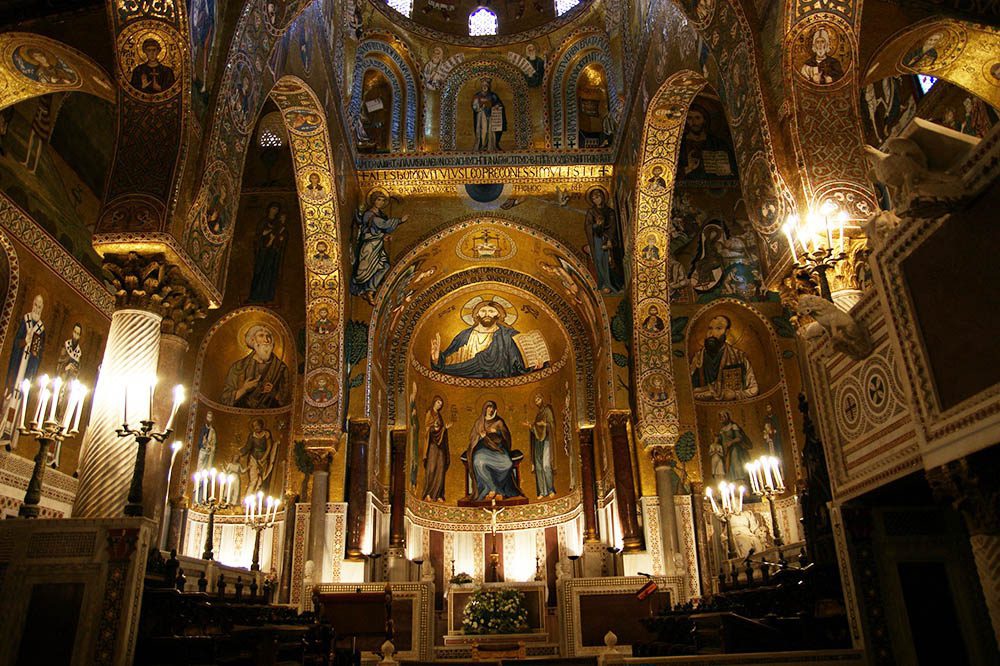
Contributed by Caroline from Veggie Wayfarer
The beautiful Palatine Chapel (Cappella Palatina) in Sicily is smack in the beating heart of the Old Town (Centro Storico) of the islands’ capital Palermo. The outside might look like nothing special, however, this UNESCO world heritage site is pretty dazzling from the inside – that is once you have passed the crumbling door, reluctant guards and the metal detector
The Palatine Chapel is located within the confines of the Norman Palace, to this day the seat of the regional government and one of the oldest buildings in the world to have served as a governmental seat consecutively. The chapel itself is the quintessential expression of 12th century Sicily, ruled by a host of different tribes all of whom put their mark on the architecture from Byzantine to Norman and even Fatimid.
The original chapel was built on the commission of King Roger II – the great Norman King – back in 1132. Stepping into the opulent, gold mosaic-covered chapel it might be hard to believe that the original intent was for the private use of the King. The mosaics depict an array of biblical scenes, each one more detailed than the next. This typical UNESCO-classified Norman architecture can be found across other villages in Sicily such as Monreale & Cefalu, easily reachable from Palermo.
Tickets for the Palatine Chapel cost €8.5 and are to be bought in the ticket office, opposite the entrance. The Palatine Chapel is located within the Norman Palace and is open from Monday to Saturday from 08.15 to 17.40 (last tickets sold at 17.00). Sundays the Chapel is open from 08.15 to 13.00, however, mass is held between 09.45 and 11.15 and therefore no visits are allowed between these hours.
The Great Spa Towns, Montecatini Terme – 2021

Contributed by Larch from The Silver Nomad
In 2021, UNESCO included a transnational series of properties. The Great Spa Towns within Europe covers eleven different spa towns in seven different countries: Austria, Belgium, the Czech Republic, France, the UK, Germany and Italy.
Although Italy has other spa towns, the only one that fulfils UNESCO’s requirements is the spa town of Montecatini Terme in the province of Pistoia, Tuscany.
Since Roman times, Montecatini Terme has been well-known as a spa town. The benefits of the thermal hot springs make Montecatini the perfect place for a wellness retreat, relaxation and even to take the waters for medical treatment.
There are three different Termes where you can try the thermal waters; these are Terme Tettuccio, Terme Excelsior and Terme Redi Thermal Complex.
The main building, the Terme Tettuccio is located in the Parco delle Terme. There are four different waters on offer from the taps in the terme. You can get a small cup to taste the different ones: Rinfresco, Tettuccio, Regina and Leopoldina. They range from slightly sweet to quite salty. They are said to offer help with a variety of different ailments.
The buildings are also very beautiful to visit. Originally built from 1779-81, the terme was then restructured in 1928.
While in Montecatini, don’t miss taking the funicular up to Montecatini Alto, the old town up on the hill.
The easiest way to get to Montecatini Terme is by train from Pisa or Florence. The termes are a short walk from the station.
UNESCO Sites in Italy Map
FAQs about the UNESCO sites in Italy
What was the first UNESCO site in Italy?
The first of the UNESCO sites in Italy were the Rock Drawings in Valcamonica which were inducted in 1979.
How many UNESCO sites are in Italy?
As of 2023, there are a total of 58 UNESCO sites in Italy.
What are the top 10 UNESCO World Heritage sites in Italy?
The top 10 UNESCO sites in Italy in 2023 are:
- Pompeii and Herculaneum
- Botanical Garden of Padua
- Church and Dominican Convent of Santa Maria delle Grazie
- Caserta Palace
- Etruscan Necropolises of Cerveteri and Tarquinia
- City of Verona
- Amalfi Coast
- Villa d’Este Palace
- The Dolomites
- Mount Etna
What are three or four UNESCO heritage Historic Centers in Italy?
There are actually 7 Historic Centres UNESCO sites in Italy where the entire city is included:
- Rome
- Florence
- Naples
- San Gimignano
- Siena
- Pienza
- Urbino
Why does Italy have so many UNESCO World Heritage Sites?
Italy has a wealth of art, culture, and natural heritage and the diverse nature of the terrain all contribute to it being the leader of UNESCO World Heritage Sites in the world.
Full List of Italian UNESCO World Heritage Sites
| Heritage Site | Where | When |
| Rock Drawings in Valcamonica | Brescia | 1979 |
| Church and Dominican Convent of Santa Maria delle Grazie with “The Last Supper” by Leonardo da Vinci | Metropolitan City of Milan | 1980 |
| Historic Centre of Rome, the Properties of the Holy See in that City Enjoying Extraterritorial Rights and San Paolo Fuori le Mura* | Metropolitan City of Rome Capital | 1980 |
| Historic Centre of Florence | Metropolitan City of Florence | 1982 |
| Piazza del Duomo, Pisa | Pisa | 1987 |
| Venice and its Lagoon | Metropolitan City of Venice | 1987 |
| Historic Centre of San Gimignano | Siena | 1990 |
| The Sassi and the Park of the Rupestrian Churches of Matera | Matera | 1993 |
| City of Vicenza and the Palladian Villas of the Veneto | Padua, Rovigo, Treviso, Metropolitan City of Venice, Verona, Vicenza | 1994 |
| Crespi d’Adda | Bergamo | 1995 |
| Ferrara, City of the Renaissance, and its Po Delta | Ferrara | 1995 |
| Historic Centre of Naples | Metropolitan City of Naples | 1995 |
| Historic Centre of Siena | Siena | 1995 |
| Castel del Monte | Barletta-Andria-Trani | 1996 |
| Early Christian Monuments of Ravenna | Ravenna | 1996 |
| Historic Centre of the City of Pienza | Siena | 1996 |
| The Trulli of Alberobello | Bari | 1996 |
| 18th-Century Royal Palace at Caserta with the Park, the Aqueduct of Vanvitelli, and the San Leucio Complex | Caserta and Benevento | 1997 |
| Amalfi Coast (Costiera Amalfitana) | Salerno | 1997 |
| Archaeological Area of Agrigento | Agrigento | 1997 |
| Archaeological Areas of Pompei, Herculaneum and Torre Annunziata | Metropolitan City of Naples | 1997 |
| Botanical Garden (Orto Botanico), Padua | Padua | 1997 |
| Cathedral, Torre Civica and Piazza Grande, Modena | Modena | 1997 |
| Portovenere, Cinque Terre, and the Islands (Palmaria, Tino and Tinetto) | La Spezia | 1997 |
| Residences of the Royal House of Savoy | Metropolitan City of Turin, Cuneo | 1997 |
| Su Nuraxi di Barumini | South Sardinia | 1997 |
| Villa Romana del Casale | Enna | 1997 |
| Archaeological Area and the Patriarchal Basilica of Aquileia | Udine | 1998 |
| Cilento and Vallo di Diano National Park with the Archeological sites of Paestum and Velia, and the Certosa di Padula | Salerno | 1998 |
| Historic Centre of Urbino | Pesaro and Urbino | 1998 |
| Villa Adriana, Tivoli | Metropolitan City of Rome Capital | 1999 |
| Assisi, the Basilica of San Francesco and Other Franciscan Sites | Perugia | 2000 |
| City of Verona | Verona | 2000 |
| Isole Eolie (Aeolian Islands) | Messina | 2000 |
| Villa d’Este, Tivoli | Metropolitan City of Rome Capital | 2001 |
| Late Baroque Towns of the Val di Noto (South-Eastern Sicily) | Catania, Ragusa, Syracuse | 2002 |
| Sacri Monti of Piedmont and Lombardy | several sites | 2003 |
| Etruscan Necropolises of Cerveteri and Tarquinia | Viterbo, Metropolitan City of Rome Capital | 2004 |
| Val d’Orcia | Siena | 2004 |
| Syracuse and the Rocky Necropolis of Pantalica | Syracuse | 2005 |
| Genoa: Le Strade Nuove and the system of the Palazzi dei Rolli | Metropolitan City of Genoa | 2006 |
| Mantua and Sabbioneta | Mantua | 2008 |
| Rhaetian Railway in the Albula / Bernina Landscapes* | Sondrio | 2008 |
| The Dolomites | several sites | 2009 |
| Monte San Giorgio* | Varese | 2010 |
| Longobards in Italy. Places of the power (568-774 A.D.) | several sites | 2011 |
| Prehistoric Pile dwellings around the Alps* | several sites | 2011 |
| Medici Villas and Gardens in Tuscany | several sites | 2013 |
| Mount Etna | Catania | 2013 |
| Vineyard Landscape of Piedmont: Langhe-Roero and Monferrato | Alessandria, Asti, Cuneo | 2014 |
| Arab-Norman Palermo and the Cathedral Churches of Cefalù and Monreale | Metropolitan City of Palermo | 2015 |
| Ancient and Primeval Beech Forests of the Carpathians and Other Regions of Europe* | several sites | 2017 |
| Venetian Works of Defence between the 16th and 17th centuries: Stato da Terra – Western Stato da Mar* | Bergamo, Udine, Verona | 2017 |
| Ivrea, Industrial City of the 20th Century | Metropolitan City of Turin | 2018 |
| The Prosecco Hills of Conegliano and Valdobbiadene. (“Le Colline del Prosecco di Conegliano e Valdobbiadene”) | Treviso | 2019 |
| Padua’s fourteenth-century fresco cycles | Padua | 2021 |
| The Great Spa Towns of Europe* | Pistoia | 2021 |
| The Porticoes of Bologna | Metropolitan City of Bologna | 2021 |
Don’t forget to pin this article so you can come back to it later

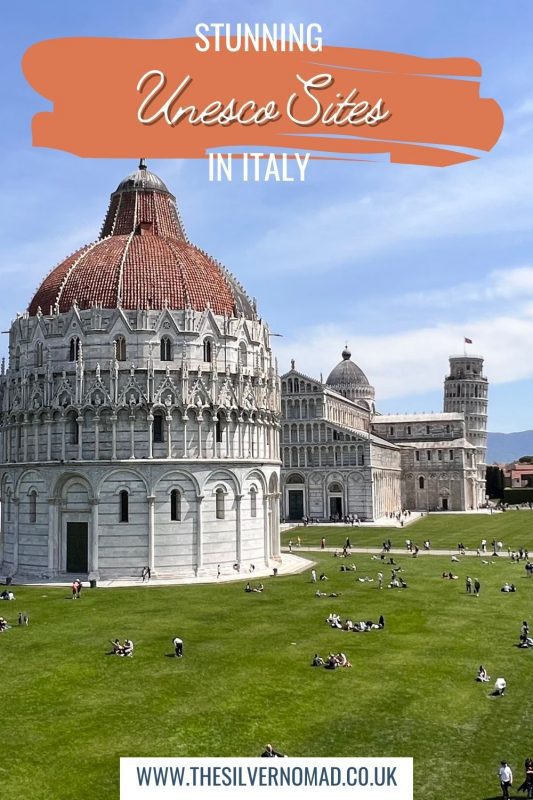
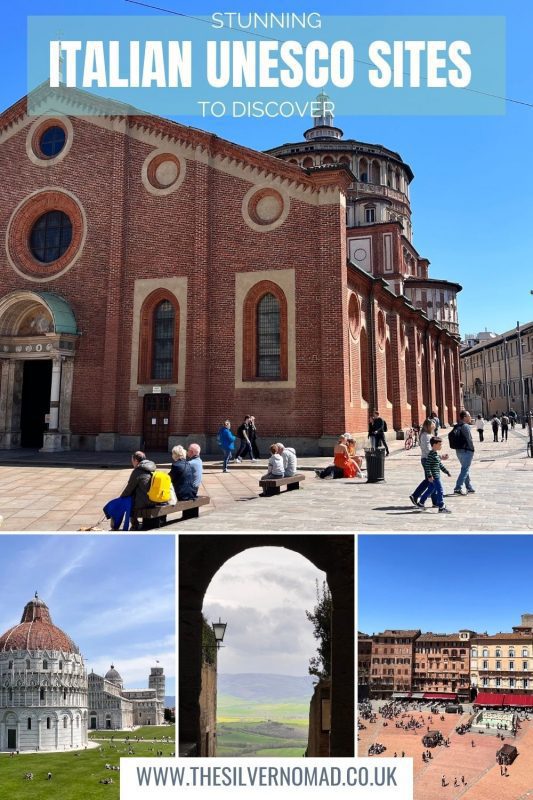
Which is your favourite of the UNESCO Heritage Sites in Italy? How many have you visited so far? Let me know in the comments below
Use these Italy Travel Tips to plan your adventure!
- Plan your trip with these Italy Travel Guides.
- Get the best deals on flights with Skyscanner.
- Find the perfect place to stay in Italy on Booking.com.
- Explore more about Italy with local experiences.
- Don’t forget to arrange your travel insurance.
- Learn Italian with an Intrepid Italian Course.
